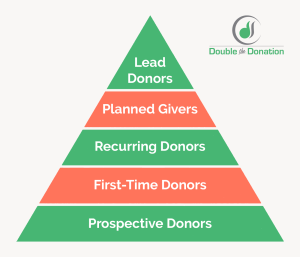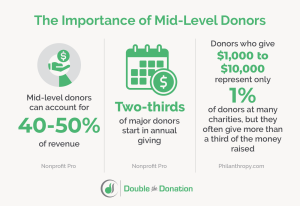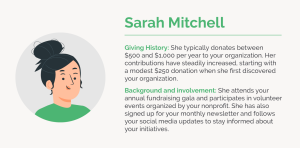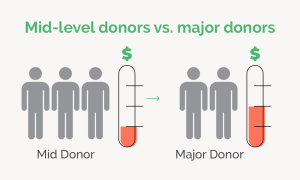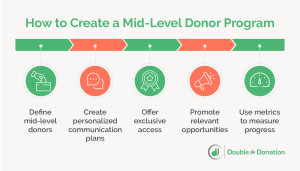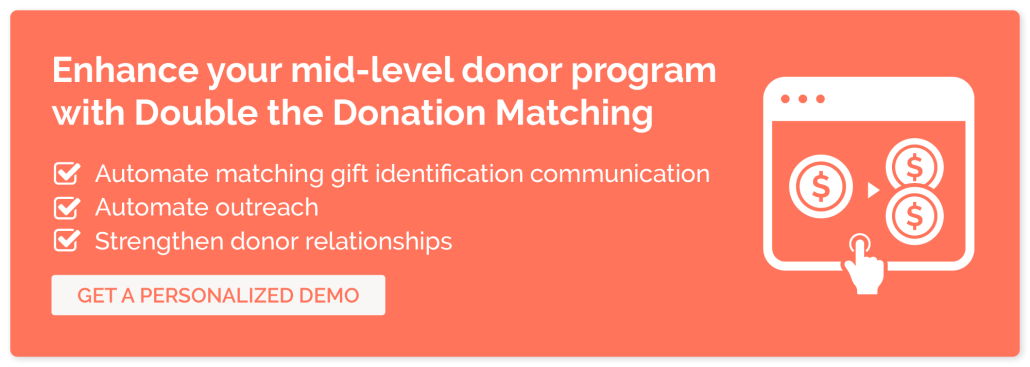Building Trust and Loyalty: Mid-Level Donor Program Basics
Because they don’t exist in the same spotlight as your major donors, it can be easy to leave mid-level donors out of your stewardship plans. However, their reliable support can contribute substantially to your nonprofit’s success.
Learn how to identify this donor group and build a compelling program to retain their support in this comprehensive guide. Here’s what we’ll cover:
- Who are your mid-level donors?
- How can you identify mid-level donors?
- Why should you create a mid-level donor strategy?
- How to create a mid-level donor program
- Best practices for mid-level donor retention
By strengthening your relationships with mid-level donors, nonprofits can eventually deepen their connection to this consistent, generous donor type. Over time this can benefit your organization by garnering regular contributions or by transforming, mid-level donors into major donors
Who are your mid-level donors?
Defining mid-level donors
Mid-level donors or recurring donors refer to the category of supporters who give more than the average donor, but less than major donors or sponsors. Visually, this group of donors falls in the middle of the donor pyramid between first-time donors and planned givers:
The amount that defines this in-between donor category will differ depending on your nonprofit’s size and should be updated regularly based on your donor data. However, a general estimate of mid-level donation amount would range from $1,000 to $10,000 given annually.
Importance of mid-level giving
Mid-level donors can easily be overlooked in the stewardship process because they don’t fall into the major donor category and usually aren’t an integral part of your nonprofit’s donor acquisition strategy. Don’t make this mistake! Mid-level donors can be game-changing for your nonprofit in several ways. Check out these statistics to learn why:
- Mid-level donors can account for 40-50% of revenue (NonProfit PRO)
- Two-thirds of major donors start in annual giving (NonProfit PRO)
- Donors who give $1,000 to $10,000 represent only 1% of donors at many charities, but they often give more than a third of the money raised (Philanthropy.com)
Characteristics and giving patterns of mid-level donors
Mid-level donors have recognizable giving characteristics and patterns that set them apart. Here’s how you can spot one:
- Donation history. Mid-level donors typically give more than the average donation but still haven’t scratched the major gift levels.
- Gift frequency and amount. As mentioned, mid-level donors typically give between $1,000 and $10,000 through regular amounts rather than one-time gifts.
- Engagement patterns. Usually, mid-level donors have another connection to your cause either through volunteering, event attendance, or social media engagement.
To make these characteristics more tangible, let’s look at an example mid-level donor profile:
Name: Sarah Mitchell
Giving History: She typically donates between $500 and $1,000 per year to your organization. Her contributions have steadily increased, starting with a modest $250 donation when she first discovered your organization.
Background and Involvement: She attends your annual fundraising gala and participates in volunteer events organized by your nonprofit. She has also signed up for your monthly newsletter and follows your social media updates to stay informed about your initiatives.
The above profile indicates that this donor has the affinity and capacity markers that would define her as a mid-level donor. Mid-level donors also tend to be more involved with your cause than the average one-time donor.
Mid-level donors vs. major donors
Because mid-level donors can be on the cusp of becoming major donors, it can sometimes be challenging to tell them apart. Fortunately, a few key distinctions can help you differentiate between mid-level donors and major donors.
Major donors typically migrate up the giving pyramid more quickly than mid-level donors. They also tend to give larger gifts less frequently. On the other hand, mid-level donors settle into giving over time and renew their gifts consistently or choose to give through multiple channels. After some time, mid-level donors usually stay at their giving rate and they rarely lapse.
How can you identify mid-level donors?
Your nonprofit CRM or donor database plays a pivotal role in identifying mid-level donors. You can segment your existing database and get a better understanding of who your mid-level donors are. For instance, you can use the following markers to characterize this group:
- Donation history analysis
- Gift amount and frequency
- Behavioral and engagement analytics
In addition to using your CRM, you can also leverage a matching gift database like Double the Donation’s to identify match-eligible donors collect even more data, and create on-demand actionable reports. With help from Double the Donation, you can identify upcoming trends, optimize mid-level donor communication channels, and establish realistic fundraising goals for every donor type. A few reports Double the Donation offers include:
- Repeat Donors Report that shows donors who have submitted requests for previous donations, but have other gifts that have not been matched.
- A General Statistics Report that indicates email open rates and click rates matches identified donations by month and provides a status breakdown to determine where your donors are in the conversion process.
- Eligible But Not Submitted Report that indicates the most valuable groups of donations that are eligible, but have not submitted matching gift requests.
Despite these benefits, many nonprofits skip cultivating mid-level donors so they can focus their time and energy on stewarding major gifts or planning direct marketing efforts. A mid-level donor program can help you intentionally steward this group. Let’s explore the basics in the next section.
Why should you create a mid-level donor strategy?
You should prioritize stewarding mid-level donors for the following reasons:
- Revenue stability. Mid-level donors offer a consistent level of support that can stabilize funding for your programs when major donors lapse or donor acquisition efforts return unfruitful. This gives your nonprofit a steady revenue stream it can build on.
- Increased giving potential. Because of their consistency and familiarity with your cause, mid-level donors have the potential to increase their giving levels or donate through planned gifts or legacy giving.
- Engagement and loyalty. Mid-level donors are reliable. A survey by Brown and Halvorsen found that two-thirds of mid-level donors surveyed said that they had supported the same nonprofits for 5+ years.
- Foundation and corporate support. Mid-level donors involved in CSR or employee engagement programs are a direct link to corporate support. Their engagement can result in increased corporate matching gifts, in-kind donations, and sponsorships.
- Networks and referrals. Mid-level donors can offer valuable connections through their personal and professional networks. For instance, a board member may be a mid-level donor and their involvement could spark the interest of friends and family.
Despite these benefits, many nonprofits skip cultivating mid-level donors so they can focus their time and energy on stewarding major gifts or planning direct marketing efforts. This is where a mid-level donor program can help you intentionally steward this group. Let’s explore the basics in the next section.
How to create a mid-level donor program
1. Define mid-level donors
Using your CRM, segment your donors to find mid-level donors that fit your predefined criteria. Choose relevant indicators such as donation amount, frequency, and involvement. For example, you might ask the following questions to identify your mid-level donors:
- Have any of your donors brought community members to events?
- What is their recurring gift status?
- How often do they volunteer?
- Have they increased their giving over time?
- Have they expressed interest in learning more about your programs or mission?
- Would they be interested in increasing their donation amount if approached in the right way?
Consistently review and update your donor profiles based on this information. As giving habits evolve, be sure to update a donor’s status, such as when a mid-level donor has achieved a major donor status.
Additionally, the criteria with which you identify your mid-level donors will change as your organization grows. Therefore, be sure to check your nonprofit’s objectives and align your team on which characteristics they can count on to spot a mid-level donor.
2. Create personalized communication plans
Personalize your communication to connect with mid-level donors in a way that acknowledges their level of giving and demonstrates impact. Take a multi-channel marketing approach to invite donors to take the next step in engaging with your organization. For example, you might launch the following initiatives as a part of your mid-level donor cultivation strategy:
- A social media campaign showcasing the results of your recurring gifts program and thanking donors who made it happen.
- An email campaign that offers a vision for your nonprofit’s future and invites mid-level donors to partner with you by volunteering or learning more in a webinar series.
- A direct mail campaign that thanks mid-level donors for their continued support and includes a brochure of how their gifts have made a difference.
- An exclusive event where beneficiaries share first-hand impact stories and guests get a sneak peek of upcoming projects and initiatives.
Rely on your donor data to pinpoint which communication channels your mid-level donors are most likely to respond best to. Find out where most of them are located as well. For instance, if most of your donors are local, an in-person gala could offer a memorable way for them to engage with you.
3. Offer exclusive access
Distinguish your mid-level donors by providing events or exclusive content that are just for them. This will encourage first-time donors to increase their engagement while recognizing the impact of mid-level donors. Some examples of this may include:
- Early access or exclusive previews of an upcoming nonprofit event.
- Free parking or prime seats at your next event.
- Behind-the-scenes tours of your new facilities.
- Exclusive “boots on the ground” content from your volunteer team.
By offering these perks and benefits, you can effectively retain mid-level donors. Just be sure to distinguish your mid-level donor stewardship program from your major gifts stewardship program. For instance, you may dedicate more formal, exclusive galas to major donors and plan quarterly volunteer workshops and lunches for mid-level donors.
4. Promote relevant opportunities
Once you’ve consulted your database, you have a better idea of your mid-level donors’ giving capacities and interests. Tailor your program to highlight relevant giving opportunities that your mid-level donors would likely agree to.
For example, if a mid-level donor has been offering a recurring gift for multiple years, you might approach them to discuss how planned gifts could help them leave a lasting legacy. Or, if a mid-level donor has a substantial social media following, you may invite them to participate in your next peer-to-peer fundraising campaign. Another option would be to invite a committed mid-level donor onto your nonprofit board to involve them in your decision-making processes.
Each of these next steps will differ depending on a donor’s giving and engagement history. However, it’s always a good idea to invite donors to get more experience with your cause to deepen their understanding and connection.
5. Use metrics to measure progress
To measure your program’s success, identify which metrics you’ll track. This will help you assess your mid-level giving program’s return on investment and help you adapt your program over time. Key metrics to keep an eye on include:
-
- Mid-level donor retention
- Conversion rate from low-level giving to mid-level giving
- Event participation rate
- Recurring gift program participation rate
- Matching gift participation
- Mid-level giving program benefits utilization
In addition to these metrics, you may also choose to calculate donor lifetime value, which estimates a mid-level donor’s value based on their potential future contributions. This metric is especially relevant to assess the long-term impact of your program and can convince your team to hone their mid-level cultivation strategy.
Best practices for mid-level donor retention
To properly select and cultivate mid-level donors, there are a few techniques to keep in mind. Following these will save your team time while maximizing each connection you make and leading your donors further down the pipeline. Let’s review them below!
Lean into automation
Planning and executing informed marketing campaigns can take time. That’s why nonprofits should lean into automation to do some of the heavy lifting for them. Email marketing, social media posting, and SMS messaging are all examples of automated marketing you can tap into to get your messages across promptly.
Another game-changing automated process is matching gift auto-submission. This technology facilitates the donor-matching gift submission process by embedding directly into a nonprofit’s donation form. All donors have to do is provide their company email address and the software will handle the rest of the matching gift process on their behalf. Check out this video for a quick overview of Double the Donation’s automation platform:
As the video explains, matching gift auto-submission has an easy setup with integrations, no developer time, no custom coding, and no additional complications. Plus, recent statistics indicate that auto-submission is projected to yield an 80% increase in matching gift revenue.
By incorporating auto-submission into your nonprofit tech stack, you can make donating matching gifts easier than ever and retain more mid-level donors.

Demonstrate impact
By reminding mid-level donors of how their giving translates into real-world impact, you’ll foster greater transparency and trust among them. Here are a few strategies you can use to effectively demonstrate impact:
- Impact reports. These comprehensive annual reports outline how your team used incoming funds to advance your mission. Specifically, they cover your organization’s activities, goals, and achievements. The report should be stocked full of progress metrics and can even be interactive with multimedia like videos, charts, and infographics inviting readers to take a deeper look at your mission.
- Testimonials. With permission, you can use volunteer, staff, and beneficiary testimonials to drive more mid-level donor support. For instance, a homeless shelter may use volunteer and beneficiary testimonials to drive home the value of a functional warming center during the cold winter months.
- Real-time statistics. To keep your audience updated at all times, you can use real-time statistics that play up your campaign’s urgency. For example, if you choose to run a time-sensitive matching gift challenge campaign, you can use fundraising leaderboards or thermometers that update matching gift progress automatically.
These techniques will keep your mid-level donors informed and excited about offering their support. And, over time, you can inspire your mid-level donors to pursue major gift status by keeping your mission top of mind.
Prioritize recognition
Did you know that 41% of donors will give again when they receive personalized outreach on the impact of their support? Providing recognition goes hand in hand with demonstrating impact and can show that your nonprofit is grateful for gifts of all sizes.
Recognize your mid-level donors as soon as the gift is received or within a 48-hour window to show your appreciation in a timely manner. An easy way to make your recognition both prompt and personalized is by using digital eCards. A platform like eCardWidget’s easy customization makes it the perfect donor recognition tool.
For example, look at how Youth For Understanding’s colorful thank-you eCards illustrate the level of creative freedom you can get with the platform:
Use quick and meaningful updates like these to thank donors, invite them to dedicated events, or even send them a happy birthday message to signal their importance to your organization.
Conclusion + Additional Resources
Mid-level donors are often the loyal sustainers of your organization. Their consistency can help you stay afloat or level up your existing programs. Use the tools and techniques listed in this article to zero in on your mid-level donors and launch an engaging program that keeps them enthusiastic about your cause.
Did you enjoy this guide to mid-level donor programs? Check out these related resources to learn more:
- Donor Retention: A Comprehensive Guide + 6 Strategies. Learn all things donor retention-related and add new strategies to your existing retention plan in this guide.
- Donor Stewardship: How to Retain Support Effectively. Learn how to make stewardship an ongoing iterative process that builds lasting relationships in this guide.
- Digital Marketing for Nonprofits: The Ultimate Guide. Make your digital marketing communications count with actionable advice from this guide.


